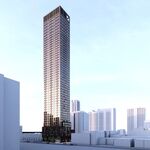M II A II R II K
Senior Member
The Only Hope for Reducing Traffic
October 19th, 2011
By Eric Jaffe

Read More: http://www.theatlanticcities.com/commute/2011/10/only-hope-reducing-traffic/315/
In 1962, transportation researcher Anthony Downs suggested that U.S. cities suffered from a fundamental law of highway congestion: "This Law states that on urban commuter expressways, peak-hour traffic congestion rises to meet maximum capacity." What was the case half a century ago remains true today. Except worse. In a research paper published in this month's American Economic Review, a pair of economists from the University of Toronto confirm the fundamental law of highway congestion, but argue it doesn't go far enough. By analyzing traffic data and road capacity in U.S. cities from 1983 to 2003, they also provide evidence for a fundamental law of road congestion — one that extends beyond interstate highways to include a "broad class of major urban roads."
- Despite the claims of highway advocates like the American Road and Transportation Builders Association, urban congestion can't be addressed by increasing road capacity. That's always been a tough fact for people to accept; as Lewis Mumford wrote back in the New Yorker back 1955: “People, it seems, find it hard to believe that the cure for congestion is not more facilities for congestion."
- The next logical solution is to increase public transportation capacity, but the Toronto researchers found "no evidence" that this impacts road congestion either. There is such an enormous latent demand for road space, they believe, that whenever a driver shifts onto public transportation, another one quickly grabs the open lane. That leaves just one solution to the traffic problem plaguing American cities: congestion pricing. "We cannot think of any other solution," says Gilles Duranton, the paper's co-author. "As soon as you manage to create space on the road, by whatever means, people are going to use that space. Except when people have to pay for it, of course."
- London's pricing program has created a number of benefits: car use is down, carbon emissions are down, delays are down, even taxi fares are down because the roads move more swiftly. Meanwhile the bus system has grown at exceptional rates, with its expansion largely paid for by the congestion pricing revenue. The more recent program in Stockholm has been an equal or even greater success. After a six-month trial period in 2006 [PDF], the city government made the program permanent the following year. Since then transit ridership is up, traffic is down some 18 percent, and in some cases rush-hour delays have been cut in half. During the trial period alone there was a huge drop in delays during evening peak traffic hours.
- Cities can try what Duranton calls quantitative restrictions. These can take the form of wholesale bans of vehicles from certain areas of the city. Some cities have tried a modified approach: in Bogota and Mexico City, for instance, cars are limited from driving on certain days based on their license plate numbers. But this strategy creates problems of its own. Bogota's Pico y Placa program restricts drivers with license plates ending in four numbers from taking to the road on any given day; but in response, says Duranton, some people simply purchase additional cars, accruing a variety of license plates to get around the system. A recent report from the Journal of Political Economy [PDF] suggests that's the case in Mexico City as well: that program led to "an increase in the total number of vehicles in circulation," writes the author. As a result, air quality in the city failed to improve.
.....
Stockholm

October 19th, 2011
By Eric Jaffe

Read More: http://www.theatlanticcities.com/commute/2011/10/only-hope-reducing-traffic/315/
In 1962, transportation researcher Anthony Downs suggested that U.S. cities suffered from a fundamental law of highway congestion: "This Law states that on urban commuter expressways, peak-hour traffic congestion rises to meet maximum capacity." What was the case half a century ago remains true today. Except worse. In a research paper published in this month's American Economic Review, a pair of economists from the University of Toronto confirm the fundamental law of highway congestion, but argue it doesn't go far enough. By analyzing traffic data and road capacity in U.S. cities from 1983 to 2003, they also provide evidence for a fundamental law of road congestion — one that extends beyond interstate highways to include a "broad class of major urban roads."
- Despite the claims of highway advocates like the American Road and Transportation Builders Association, urban congestion can't be addressed by increasing road capacity. That's always been a tough fact for people to accept; as Lewis Mumford wrote back in the New Yorker back 1955: “People, it seems, find it hard to believe that the cure for congestion is not more facilities for congestion."
- The next logical solution is to increase public transportation capacity, but the Toronto researchers found "no evidence" that this impacts road congestion either. There is such an enormous latent demand for road space, they believe, that whenever a driver shifts onto public transportation, another one quickly grabs the open lane. That leaves just one solution to the traffic problem plaguing American cities: congestion pricing. "We cannot think of any other solution," says Gilles Duranton, the paper's co-author. "As soon as you manage to create space on the road, by whatever means, people are going to use that space. Except when people have to pay for it, of course."
- London's pricing program has created a number of benefits: car use is down, carbon emissions are down, delays are down, even taxi fares are down because the roads move more swiftly. Meanwhile the bus system has grown at exceptional rates, with its expansion largely paid for by the congestion pricing revenue. The more recent program in Stockholm has been an equal or even greater success. After a six-month trial period in 2006 [PDF], the city government made the program permanent the following year. Since then transit ridership is up, traffic is down some 18 percent, and in some cases rush-hour delays have been cut in half. During the trial period alone there was a huge drop in delays during evening peak traffic hours.
- Cities can try what Duranton calls quantitative restrictions. These can take the form of wholesale bans of vehicles from certain areas of the city. Some cities have tried a modified approach: in Bogota and Mexico City, for instance, cars are limited from driving on certain days based on their license plate numbers. But this strategy creates problems of its own. Bogota's Pico y Placa program restricts drivers with license plates ending in four numbers from taking to the road on any given day; but in response, says Duranton, some people simply purchase additional cars, accruing a variety of license plates to get around the system. A recent report from the Journal of Political Economy [PDF] suggests that's the case in Mexico City as well: that program led to "an increase in the total number of vehicles in circulation," writes the author. As a result, air quality in the city failed to improve.
.....
Stockholm





